Physical Address
304 North Cardinal St.
Dorchester Center, MA 02124
“It is amazing the frequency in medical history, with which ideas are lost and reinvented” George Bernard Shaw
Establishing and maintaining airway patency and providing support of oxygenation and ventilation are essential skills for many health care practitioners including anesthesiologists. The anesthesia face mask (FM) and tracheal tube once constituted the bulk of airway management apparatus. However, shifts in demographics, advances in surgical procedures, patient size and weight, and the need to control and manage the airway not only in the surgical context but also out of the operating room (OR) have led to a revolution in the modern tools of airway management. Of all the equipment in the toolbox of the anesthesiologist, airway management devices may be the most commonly used, as well as the most varied in design and function. In the first two decades of the 21st century there has been a great expansion and evolution of available tools, and we have witnessed the appearance of new devices and techniques, as well as fading of others that were prominent even just a decade ago.
There have been major advances in both routine and rescue tools, such as supraglottic airways (SGAs), video laryngoscopes and minimally invasive devices, with the introduction of Complementary Metal Oxide Semiconductor (CMOS) imaging technology, increased availability of single-use (disposable) devices (prompted by concerns over infection control issues), the use of newer noninvasive high flow-pressure oxygenation devices, and patient positioning devices. This chapter focuses less on historic devices and more on the forces guiding instrument evolution; that is, the causes, pressures, and findings that led to device development. The exception to this is a historical discussion of the origins of airway management, including tracheal intubation and video-laryngoscopy.
Basic airway maneuvers such as establishing and maintaining airway patency and/or achieving noninvasive and invasive airway access require proper patient head and neck positioning.
The tongue and soft palate are two important sources of obstruction in anesthetized and sedated patients and this obstruction may be more pronounced in obese patients. Simple maneuvers such as the “triple airway maneuver”: chin lift (CL), head extension (HE) at the occipito-atlanto-axial joint, and jaw thrust (JT: prognathic mandibular displacement at the temporomandibular joint) can relieve airway obstruction at the level of the tongue and soft palate; however in many patients airway devices such as oropharyngeal and nasopharyngeal airways (OPAs and NPAs) are needed.
An oropharyngeal airway (OPA) is one of the most common devices used to provide airway patency. The OPA has a caudally facing, concave surface; the preformed concavity follows the oropharyngeal anatomy as it comes to its final position along the contour of the tongue. , The proximal end has a flange to keep the device stabilized at the lips. An air channel is often provided to facilitate ventilation and oropharyngeal suctioning. The OPA will bypass the nasal cavities, nasopharynx, and soft palate obstruction in inspiration and exhalation, lift the tongue and possibly the epiglottis, support mandibular advancement, and improve the bag-mask ventilation (BMV) seal in edentulous patients. Because of the position against the base of the tongue and posterior pharyngeal wall, OPAs are poorly tolerated in the awake or inadequately anesthetized patient. Complications can occur with the use of OPAs, such as iatrogenic trauma and airway hyperreactivity. Minor trauma, including pinching of the lips and tongue, is common. Ulceration and necrosis of oropharyngeal structures from pressure and long-term contact (days) has been reported. Proper surveillance and vigilance are recommended in prolonged use. Dental injury can result from twisting of the airway, involuntary clenching of the jaw, or direct axial pressure. Dental damage is most common in patients with periodontal disease, dental caries, and poor dentition. Oropharyngeal and laryngeal reflexes can be stimulated by the placement of an artificial airway. Coughing, retching, emesis, aspiration, laryngospasm, and bronchospasm can occur. OPAs come in a wide variety of sizes, from neonatal to large adult and they are typically made of plastic or rubber. Some of the commonly available oral airways include the Berman, Guedel, and the Berman-Split. The Ovassapian and Williams airways are designed for use with a flexible laryngoscope ( Fig. 14.1 ).
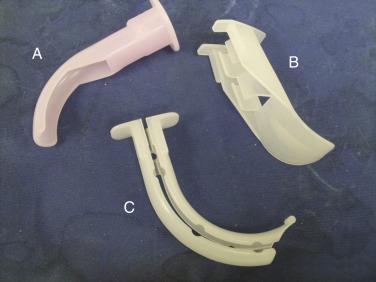
The nasopharyngeal airway (NPA) is a (now) disposable soft tubular device designed to support the nasal route of breathing, controlling airway obstruction at the nasal cavities, nasopharynx, soft palate, and the base of the tongue. They are sized based on their outer diameter (OD) in French scale and come in sizes from 12-36 Fr (Fr [French size] is the circumference in millimeters). The larger OD is also reflected in a longer length. A proximal flange stabilizes the NPA at the naris while the distal end is beveled and ideally comes to rest approximately 10 mm above the epiglottis when fully inserted. Awake patients tolerate NPAs better than OPAs ( Fig. 14.2 ). As with the OPAs, the NPAs have a caudad, albeit more gentle, concavity. Appropriate nasal airway sizing is determined by measuring the distance from the patient’s bony mandible or nostril to the external auditory meatus. The NPA is typically lubricated with a water-based lubricant (with or without a water-soluble local anesthetic) and then gently but firmly inserted through the caudad part of the nasal passage, following the posterior wall of the nasopharynx and oropharynx, coming to lie with the tip in the hypopharynx. The tip of the NPA is beveled in order to minimize trauma when advancing through the nasal cavities and the nasopharynx. The most common complication of NPA use is epistaxis. Contraindications to the use of NPAs include nasal fractures, marked septal deviation, coagulopathy, basilar skull fractures, cerebrospinal fluid (CSF) leak, pregnancy, transsphenoidal surgical procedures, and Caldwell-Luc procedures.

The face mask (FM) is one of the oldest airway devices in use today. François Chaussier used a symmetrical FM for resuscitation in 1780, and the original FM concept is maintained to this day. FM ventilation, also known as bag-mask ventilation (BMV), is an essential component of modern airway management plans. , , The goal of BMV is to provide positive-pressure gas movement through a patent’s otherwise unprotected airway. Successful BMV should be defined by both clinical (chest movement, excessive gas leak) and objective (sustain oxygen saturation and waveform-exhaled carbon dioxide, peak airway pressure and exhaled tidal volume) measurements. The adult FM is designed to reduce anatomic dead space, improving the seal between the face and the mask. FMs have been manufactured using a variety of materials, shapes, and types of seals. They are composed of three main parts: a body, a seal (or cushion), and a 22-mm connector for a positive pressure-generating device. The body is the primary determinant of the mask’s shape. Modern disposable FMs are made either of silicone or rubber. In the past, anesthesia masks were opaque, but most modern anesthesia masks are clear to allow the provider to view the patient’s lip color, condensation from exhalation, secretions, vomitus, and blood. They have high-volume/low-pressure inflatable seals (cuffs). The FM is held over the patient’s face covering the nose and mouth. One-handed FM ventilation is a complex technique and requires skill and practice: one hand lifts the chin and maintains the head extension while maintaining the mask seal. Two fingers are placed over the body of the mask (one above the chin and one over the bridge of the nose) to firmly hold it in place, and three fingers are placed along the bony mandible to complete a tight seal. In edentulous patients, it may be necessary to include the chin of the patient in the mask to compensate for the lack of dentition. The operator’s other hand establishes ventilation with positive pressure by means of an inflatable bag. The proper use of an FM assumes an optimal effective seal and the patency of the upper airway. The seal should permit maintenance of an airway pressure of 20 to 25 cm H 2 O with minimal or no leak. The mask should comfortably fit the hand of the user and the face of the patient. Coordination of these tasks determines the achievable upper airway pressures.
When positioning the mask, the clinician must be careful not to compress the facial nerve and artery, the eyes, or the lips. FM fit can be maintained with the help of a head strap ( Fig. 14.3 ) attached to a four-prong ring that encircles the circuit fitting on the mask. The head strap is helpful for the clinician with small hands, when the patient is edentulous or has a large face or beard, or to allow providers to have their hands free when the patient is breathing spontaneously.
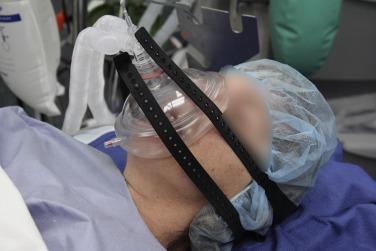
A newer design concept, the asymmetric ergonomic FM (ErgoMask, Touren Medical, Richards Medical Equipment, Wheeling, IL), places the airway breathing circuit connector off-center to provide a better seal when one-handed BMV is used. The clinician applies a CL with the left third and fourth digits, with the left thumb positioned maximally on the right side of the mask and the second digit on the rim, gripping the whole mask and applying a tight seal ( Fig. 14.4 ).
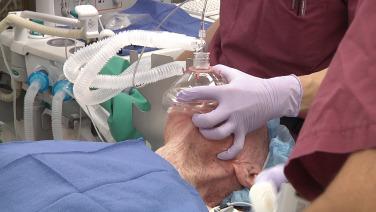
The VBM Endoscopy Mask (VBM Medical, Sulz, Germany) incorporates a diaphragm that allows simultaneous ventilation during oral or nasal endoscopy procedures, including flexible scope intubation, bronchoscopy, gastrointestinal endoscopy, and transesophageal echocardiography procedures ( Fig. 14.5 ).
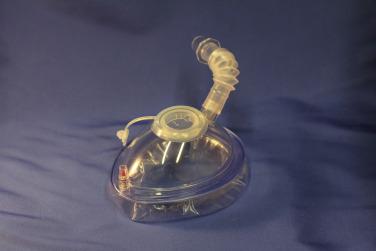
The Flow-Safe II (Mercury Medical, Clearwater, FL) is a disposable FM designed to deliver Continuous Positive Airway Pressure (CPAP). It incorporates a manometer for verifying CPAP pressure and a pressure-relief system. The Flow-Safe II works with standard O 2 delivery systems and is capable of generating >10 cm H 2 O pressure at flows of 15 L/min. There is a variant called the Flow-Safe II EZ CPAP System with an incorporated nebulizer system.
The Boussignac mask (Vygon, Écouen, France) generates CPAP by use of a turbulence flow valve that is flow dependent, and works with standard oxygen delivery systems. When properly positioned using standard FM straps to secure the seal on the patient’s face, it is capable of generating >10 cm H 2 O pressure at flows of 15 L/min ( Fig. 14.6 ).
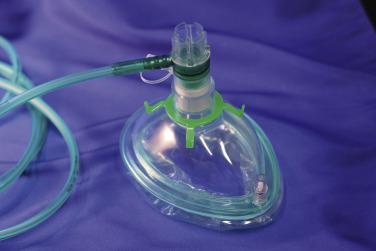
The SuperNO2VA (Vyaire Medical, Mettawa, IL) is a nasal-only positive-pressure ventilation system, functionally stenting open the nasal-to-hypopharyngeal airway. It is used for sedation anesthesia, cases involving upper endoscopy (mouth is unoccluded), preoxygenation, positive-pressure (nasal only) ventilation, and continued oxygenation during laryngoscopy. It can be used with either an anesthesia breathing circuit or with an oxygen flow meter as a source of oxygen. Studies have shown increased tidal volume with nasal-only ventilation ( Fig. 14.7 ).
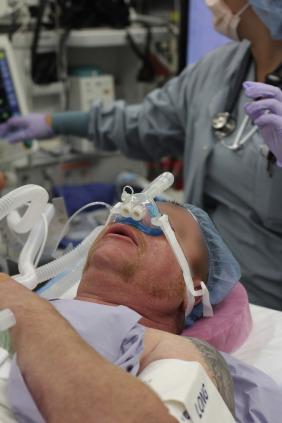
Although optimal patient positioning has long been recognized as an essential component of airway management, none of the major airway management guidelines overtly provide information on ideal head and neck positioning for bag-valve-mask ventilation (BVM) and other instrumentation. Positioning is especially important in obese patients. Magill described the classic “sniffing position” with elevation of the occiput and extension of the head at the atlanto-occipital joint as the best position for direct laryngoscopy. In 1994 MacBeth and Bannister described the “three axes alignment theory” by which the mouth and pharyngeal and laryngeal axes are brought into alignment by neck flexion and extension around the atlanto-occipital joint. In 2003, Levitan coined the term Head Elevated Laryngoscopy Position (HELP) as a better technique for glottic exposure during direct laryngoscopy. In 2010, Greenland et al . described the importance of a direct line between the sternal notch and external auditory meatus as the optimal technique for glottic exposure in morbidly obese patients. Bed/stretcher height elevation with the patient’s forehead at the xiphoid process of the anesthesia caregiver will provide better views of the larynx. The Fowler’s position (semi-seated) or reverse Trendelenburg position help to delay hypoxemia in obese and nonobese patients. Using a 20-degree head-up position in non-obese anesthetized apneic patients can prolong the safe apnea period (SAP) of patients in a supine position or those with positive end-expiratory pressure (PEEP). Although the proper positioning can be achieved using blankets and towels and even the OR table, there are commercially available products that aid in proper patient positioning.
The Troop Elevation Pillow (Troop Medical, San Antonio, TX) is a sturdy foam pillow designed to place the patient in a head-elevated position to facilitate face mask ventilation (FMV) and laryngoscopy in normal-weight and obese patients. Separate head and arm support can be used. Single-use and vinyl-covered multipatient use pillows are available.
The Pi positioning device (American Eagle Medical, Uniondale, NY) is a two-part pillow with a base that supports the back and head with a removable occiput pad. The two parts, when assembled, provide comfortable patient positioning. Once general anesthesia is induced, the occiput pad is removed and the patient’s head achieves a “sniffing” position. There is a range of sizes from pediatric to morbidly obese adult. Once a sniffing position has been achieved, the pillow also facilitates central line placement, interscalene brachial plexus blockade, and surgical procedures such as thyroidectomy and laryngectomy.
Maintaining adequate oxygenation during the perioperative period, including during airway management maneuvers, is one of the most important tasks of anesthesia providers and is the cornerstone of the safe and uncomplicated conduct of advanced airway management. There is an ever-growing number of techniques to improve oxygenation and prolong the safe apnea period before, during, and after airway management as well as during sedation and nonoperative anesthesia cases. These include traditional oxygen delivery methods such as FM and nasal cannula and pharyngeal oxygen insufflation, noninvasive positive-pressure ventilation (NIPPV) systems, and high-flow nasal cannula systems. These techniques have evolved and have become especially useful for patients at risk for desaturation during advanced airway management.
The administration of supplemental oxygen via a nasal cannula that is placed under a traditional FM has been demonstrated as a method to decrease desaturation events during airway management. In 1988, Teller showed that the safe apnea period could be extended up to 10 minutes using a nasal cannula during apnea in 12 healthy patients. In 2012, Levitan and Weingart coined the acronym NODESAT (Nasal Oxygen During Efforts Securing A Tube) to describe the technique of nasal-cannula-under-facemask, a technique that was then applied primarily in emergency medicine, but has also been adopted in some intensive care unit (ICU) and OR settings. Once the patient has been rendered apneic, the nasal cannula flow rate is increased to 15 L per minute (the flow limit of most pressure-compensated flowmeters). At this flow rate, a fraction of inspired oxygen (FiO 2 ) of nearly 100% is achieved, facilitating apneic oxygenation. An important requirement of the technique is the need to maintain airway patency throughout laryngoscopy attempts either by jaw thrust or by the laryngoscope itself.
Maximizing preoxygenation by combining 100% oxygen with NIPPV, including PEEP in the reverse Trendelenburg position, has been recommended in patients at high risk of hemoglobin desaturation. These populations include the obese, elderly and extremely young, pregnant, and critically ill patients due to reduced functional residual capacity, increased risk of atelectasis, and/or right-to-left shunt. NIPPV and PEEP serve to increase mean airway pressure and recruit alveoli that contribute to increased right-to-left shunt.
High-flow nasal-warmed, humidified oxygen administration (HFNO) at flows of 30 to 70 L/min is a new modality in oxygen administration in anesthesia and outside the OR (e.g., emergency department [ED] and ICU) ( Fig. 14.8 ). In 2015 Patel et al. coined the term THRIVE (Transnasal Humidified Rapid-Insufflation Ventilatory Exchange). In their study, THRIVE was used in 25 patients undergoing hypopharyngeal or laryngotracheal procedures and in whom rapid oxygen desaturation during the induction of anesthesia was likely. THRIVE was administered from the preoxygenation phase throughout induction of general anesthesia and neuromuscular blockade until a definitive airway was secured. The median apnea time was 14 minutes with a range of 5–65 minutes. No patient desaturated below 90%. The mean ± S.D. postapnea end-tidal CO 2 level was 58.5 ± 18 mm Hg, with a range of 36.8 to 114.8 mm Hg; the average rate of end-tidal CO 2 rise was 1.1 mm Hg per minute. Although the mechanisms of action and physiological effects of HFNO are not yet fully understood, it is proposed that pharyngeal dead space “washout,” decreased airway resistance, generation of PEEP, and cardiogenic oscillations are responsible for the limitation of hypercarbia. In the ICU setting, HFNO is effective at improving oxygenation in most patients with hypoxemic acute respiratory failure of different etiologies. This modality of continuous oxygenation holds the potential to improve oxygenation during difficult airway management, allowing health care practitioners to approach airway instrumentation as a smooth event rather than a hurried, potentially traumatic undertaking.
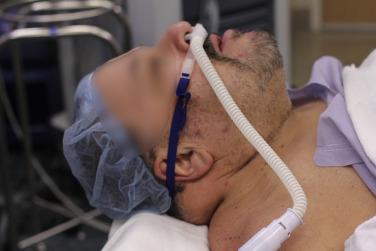
The art of anesthesia using a tracheal tube is more than 100 years old. The first orotracheal intubation anesthetic was performed in 1880 by Glasgow surgeon Sir William Macewen.
Indications for tracheal intubation include positive-pressure ventilation, pulmonary toilet, and airway protection. Tracheal tubes (TTs) initially were made of rubber and were reusable. However, these devices were prone to kinking and were unsuitable for patients sensitive to latex. Tracheal tubes today are made of many materials, although the most commonly used material is polyvinylchloride (PVC). PVC is inexpensive, the tubes conform to patient’s anatomy through thermoplasticity, and the tubes are more resistant to kinking. Tracheal tubes must conform to the International Organization for Standardization (ISO) (standard ISO 5361:2016) which include specifications for internal diameters (IDs) and outer diameters (ODs), distance markers from the distal end to anesthesia circuit adapter, material toxicity, angle and direction of the bevel, size and shape of the Murphy eye, and radius of the tube curvature. Tracheal tubes may either be cuffed or uncuffed; the cuff provides a seal between the TT and trachea, thereby protecting the trachea from aspiration of gastric contents and facilitating positive-pressure ventilation. Tracheal tubes in use today have high-volume, low-pressure cuffs that disperse force on the tracheal tissues ( Fig. 14.9 ).

Armored TTs, either anode or flexo-metallic, have an embedded metal or nylon wire wound in a spiral throughout the shaft of the tube. These tubes are resistant to kinking and compression and often are used in head, neck, and tracheal surgery and in positions in which the neck is flexed. A disadvantage of this tube’s construction is that once it is kinked or compressed, it does not revert to its original shape. This can result in partial or complete airway obstruction ( Fig. 14.10 ).
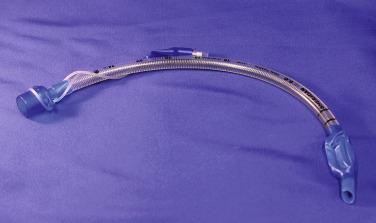
Preformed tubes, such as the Ring-Adair-Elwyn (RAE) tube, have a manufactured, preformed bend that can be used to direct the connector away from the surgical field. Nasal and oral designs are available. They are predominantly used in oromaxillofacial and nasal procedures ( Fig. 14.11 ).
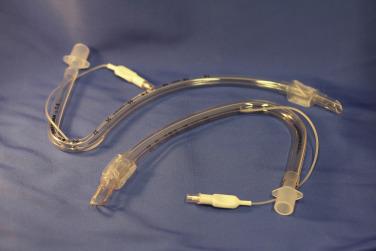
The Parker Flex-Tip TT (Parker Medical, Highlands Ranch, CO) is designed to facilitate the passage of the tube into the trachea during endoscopic-aided intubation. Space between the bevel of standard tracheal tubes and a flexible endoscope may result in entrapment of the right arytenoid cartilage, vocal folds, or other structures during advancement. However, the bevel of the Parker Flex-Tip tube decreases the gap between the endoscope body and the TT, thereby increasing the success of first-attempt passage of the TT ( Fig. 14.12 ).
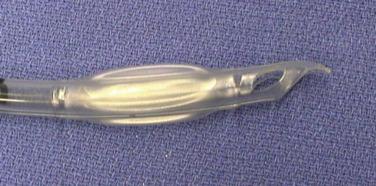
Airway fires due to ignition of the TT is the most serious danger associated with the use of lasers in the OR (see Chapter 24 ). The risk is especially acute when lasers are used in airway surgery. The ignition is related to the tube material, the concentration of oxygen or nitrous oxide delivered from the anesthesia circuit, and direct contact of a heat source. Conventional PVC tracheal tubes are flammable and should not be used during airway laser surgery. The potential for TT combustion can be reduced (but never eliminated) by using TTs made from noncombustible materials. Despite this, tracheal tube cuffs are not laser resistant and are prone to puncture, and therefore often filled with saline or water and a dye indicator to enhance detection of accidental cuff compromise. Leakage of the colored solution will alert the surgeon to the laser strike. Commercially available laser-resistant tubes are either metallic or a mixture of metal and silicone and may have double cuffs (proximal and distal) as a safeguard in case of accidental cuff damage ( Fig. 14.13 ).
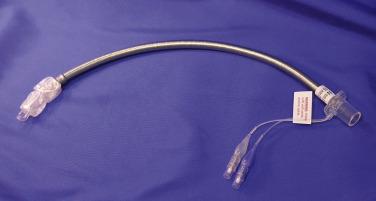
The Hunsaker Mon-Jet tube (Medtronic Xomed, Jacksonville, FL) is designed for elective jet ventilation. The tube consists of a flexible, collapsible cage that positions the distal end of the tube in a midline tracheal position, a 3-mm laser-resistant shaft with a stylet, and a carbon dioxide sampling line. The Hunsaker tube has a Luer-lock port that allows for connection to a jet ventilation device. The carbon dioxide sampling line allows for monitoring of the end-tidal carbon dioxide concentration or airway pressure in an effort to avoid barotrauma. This tube can be used with both carbon dioxide and yttrium-aluminum-garnet (YAG) lasers ( Fig. 14.14 ).

Manufactured of polyurethane (PU), the Tritube (Ventinova Medical, Eindhoven, The Netherlands) is a small, 4.4-mm OD, triple lumen tracheal tube with a ventilation lumen that has a Murphy eye, an ID less than 3 mm, a high-volume low-pressure cuff, and an intratracheal pressure measurement lumen. The Tritube is used either with an Evone ventilator (Ventinova Medical, Eindhoven, The Netherlands) that creates active exhalation employing a Bernoulli device or the Ventrain manual ventilator ( Fig. 14.15 ).
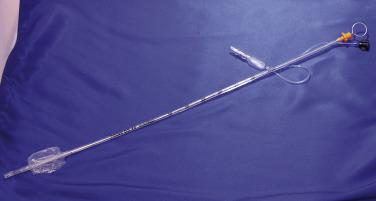
Hospitalized patients who require mechanical ventilation are susceptible to the development of aspiration pneumonia. Ventilator-associated pneumonia (VAP) is known to increase hospital length of stay, health care costs, and mortality. Organisms that collect in pooled subglottic secretions above the inflated cuff of the TT have previously been unmeasurable with any reliability but now have been demonstrated to be a major source of VAP. Several medical and nursing care measures may be taken to reduce the incidence of VAP caused by this route, including personnel handwashing, improved and frequent oral care, elevating the head of the bed past 30 degrees, frequent suctioning, and ensuring postpyloric positioning of tube feedings; however, none of these measures will completely eliminate the collection of secretions.
The presence of these pooled collections has led to the development of specific TTs with a dedicated suction system capable of emptying this area of debris. Drainage of subglottic secretions has been shown to prevent VAP. The currently available subglottic drainage TTs have a suction lumen that opens on the external (posterolateral) surface of the TT immediately above the cuff. The lumen is connected to constant or intermittent suction for active drainage of the subglottic space. Although these TTs are beneficial, their efficacy is not 100%, and therefore all of the aforementioned nursing care actions remain important in the prevention of VAP. The subglottic drainage tubes continue to be refined in cuff construction (materials, shapes, volumes, locations) and suction capabilities that help to reduce aspiration of the subglottic debris. Subglottic secretions are not the only recognized cause of VAP, however. Biofilm is an accumulation of debris adherent to the internal surface of the TT and is composed of tissue, secretions, mucus, and a bacterial load. Biofilm can be aspirated, resulting in a source of infection, or cause obstruction to airflow. Biofilm may contribute to luminal narrowing of the TT with resultant increases in airway resistance. Biofilm removal and reduction through oral hygiene and routine TT care have been demonstrated to minimize these complications. Although mechanical options for treatment are available and discussed later in this chapter, no better method exists than prevention. As such, there is growing interest in the reduction of biofilm through construction of TTs impregnated with antimicrobial agents. The ability of such developments to affect the incidence of VAP has not yet been proven.
Since the 1940s, the most common device used to facilitate tracheal intubation has been the direct laryngoscope (DL). A rapid, easily learned, and highly successful technique, direct laryngoscopy has enjoyed universal acceptance. , , The practice of direct laryngoscopy is one of creating a nonanatomic access through a line of sight from the operator to the larynx. With the introduction of devices such as video (indirect) laryngoscopes, direct laryngoscopy is likely to have reduced importance in the future.
All DLs have three basic components: the handle, the blade, and the light source. Although the modern DL in use by the anesthesia caregiver is based on a right-angle relationship of the handle and blade (with some exceptions), U-type configurations remain popular in otolaryngology. Although fixed-handle blades have been used in the past, most modern systems use a folding latch connector between the two, which also acts as a switch for powering the source of illumination by a variety of mechanisms. Adaptors that can be placed between the handle and blade allow the right angle to be modified to accommodate various clinical situations.
The first DLs used external light sources—direct sunlight, head mirrors, and headlamps—to illuminate the larynx. In 1902, Einhorn developed a light-bulb carrier that could be mounted on the blade. In 1907, Jackson developed a blade that used this carrier to provide distal illumination. In 1913, batteries were incorporated into the handle by Janeway.
The DL blade is used to create an axis of visualization to the larynx. The blade spatula compresses the tongue into the mandibular space, while the flange (if present) is used to move the tongue laterally and create a visual lumen. The spatula may be straight, curved, or angular, but the resulting lumen must be a straight line. Flanges have been designed in a variety of cross-sectional shapes that include C, U, and O shapes (the O shape is a completely enclosed tube). The cross-sectional height of the flange is termed the step.
The distal end of the blade is referred to as the tip and is used to lift the epiglottis. The tip may be placed either underneath the epiglottis, to lift it directly, or in the vallecula, where stretching of the glosso-epiglottic ligament causes epiglottic elevation. The tip generally is blunt and thickened to reduce trauma.
Although more than 50 different DL blades have been designed and marketed, the straight Miller blade and curved Macintosh blade are predominant in clinical use. In lieu of a detailed discussion of each, the unique properties of various blades are highlighted in Box 14.1 . In the last decade, and due to stricter infection control prevention emphasis by The Joint Commission, many health systems and groups have moved towards use of single-use laryngoscope blades and handles. Several manufactures offer single-use systems. The environmental and economic impact of this practice remains in question ( Fig. 14.16 ).
Introduced in 1941. Longer than previous blades. Rounded bottom. Small distal tip. Curve begins 2 inches from the tip.
Requires less interincisor space. Used by epiglottic entrapment (direct lift).
Sharply curved blade with large flange. Indirect lifting of the epiglottis by stretching of the glossoepiglottic ligament. Reduced plane of anesthesia required because the posterior surface of the epiglottis, innervated by a branch of the vagus nerve, is not stimulated.
Straight blade, large cross-sectional diameter. Used for a paraglossal technique.
Provides improved view for patients with small oral aperture or enlarged base of tongue.
Hinged tip (70 degrees of movement) is controlled by lever along handle.
Provides improved view for patients with small oral aperture or enlarged base of tongue.
Blade in line with handle. Developed for the “iron lung” patient.
Avoids obstructions over the patient’s chest (large breasts, morbid obesity, operator hand performing Sellick maneuver).
Angle of handle/blade is 20 degrees more obtuse than standard Macintosh blade.
See polio laryngoscope blade.
Adapter between blade and handle to increase handle/blade angle.
See polio laryngoscope blade.
Adjustable angle adapter (180-, 135-, 90-, and 45-degree angles).
See polio laryngoscope blade.
Adapter between blade and handle allows 90-degree pivoting (lateral) position change.
10.5-cm straight blade.
For patients <5 years.
Short, straight blade with slight 2.5-cm distal curvature. C-shaped cross-section (right-side open) with 1.8 cm width (proximal) tapering to 1 cm (distal).
For newborns to children aged 3 years.
Miller-type blade shortened to 6.7 cm. Relatively distal lamp.
Infant blade, improved illumination.
Integrated suction channel on a standard Macintosh blade.
Continuous suction during intubation attempt.
Integrated suction channel on a standard Miller blade with thumb valve control.
Intermittent suction during intubation attempts.
Equivalent in size to a size 2 Macintosh blade, with a tapered profile similar to a Miller blade, and can be used in adults and in children weighing >10 kg.
Has 10- and 20-kg markings on the blade to aid in depth of insertion into the oropharynx.
Become a Clinical Tree membership for Full access and enjoy Unlimited articles
If you are a member. Log in here